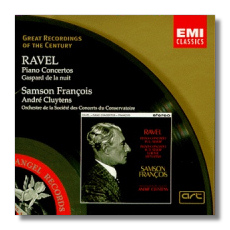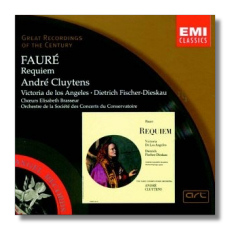
The Internet's Premier Classical Music Source
Related Links
-
Fauré Reviews
Gluck Reviews
Handel Reviews
Mahler Reviews
Mendelssohn Reviews
Purcell Reviews
Ravel Reviews
Schubert Reviews - Latest Reviews
- More Reviews
-
By Composer
-
Collections
DVD & Blu-ray
Books
Concert Reviews
Articles/Interviews
Software
Audio
Search Amazon
Recommended Links
Site News
 CD Review
CD Review
Great Recordings of the Century

Maurice Ravel
- Piano Concerto in G Major
- Piano Concerto in D Major for the Left Hand
- Gaspard de la nuit
Samson François, piano
Paris Conservatoire Orchestra/André Cluytens
EMI Classics 66957 ADD 60:54


Gabriel Fauré
- Requiem
Victoria de los Angeles, soprano
Dietrich Fischer-Dieskau, baritone
Chœurs Elisabeth Brasseur
Henriette Puig-Roget, organ
Paris Conservatoire Orchestra/André Cluytens
EMI Classics 66946 ADD 39:55


Franz Schubert
- Die schöne Müllerin
Dietrich Fischer-Dieskau, baritone
Gerald Moore, piano
EMI Classics 66959 ADD 62:36


- Gustav Mahler: Kindertotenlieder 1
- Christoph Willibald Gluck: Orfeo ed Euridice: Arias: 4
- Chiamo il mio ben così
- Deh! placetevi con me!
- Che puro ciel!
- Che farò senza Euridice?
- Henry Purcell: 2,3
- Sound the trumpet, Z. 335
- Indian Queen, Z. 630 "Let us wander not unseen"
- King Arthur, or The British Worthy, Z 628: "Shepherd leave"
- Felix Mendelssohn: 2,3
- Duet, Op. 63 #1 "Ich wollt' meine Lieb'"
- Duet, Op. 63 #3, "Gruss"
- George Frideric Handel: Ottone, HWV 15 3
- La speranza è giunta in porto
- Vieni, o figlio, e mi consola
- Maurice Greene: 3
- O praise the Lord, ye that fear him
- O God of my righteousness: I will lay me down in peace
Kathleen Ferrier, contralto
1 Vienna Philharmonic Orchestra/Bruno Walter
2 Isobel Baillie, soprano
3 Gerald Moore, piano
4 Orchestra & Chorus of the Netherlands Opera/Charles Bruck
EMI Classics 66963 ADD monaural 75:02


Gustav Mahler
- Das Lied von der Erde
Christa Ludwig, mezzo-soprano
Fritz Wunderlich, tenor
Philharmonia & New Philharmonia Orchestras/Otto Klemperer
EMI Classics 66944 ADD 64:07
This is a sampling of CDs from EMI Classics' new "Great Recordings of the Century" series, a project that is surveying the most treasured recordings from the label's back catalogue and presenting them to consumers in new digital remasterings and packaging that stimulates the centers in your brain where LP nostalgia occurs. If you think that this approach sounds similar to that used in the Deutsche Grammophon Originals and Sony Masterworks Heritage series, you're right!
Samson François was nothing if not unpredictable, and his predilection for saying outrageous things was matched by his pianism, which also was outrageous, in every sense of the word. He was loved in his native France and often reviled elsewhere, except by connoisseurs who saw past his surface idiosyncrasies and valued his passionate, illuminating musicianship.
Few of his records sold better than the Ravel concertos that he and Cluytens recorded together in 1959. The G-Major concerto is given the most Gallically offhand treatment possible. François smears runs and smudges Ravel's intricately planned effects. One almost intuitively knows that he does this not out of technical necessity, but out of a wish to be spontaneous and perhaps a little naughty. The composer's dynamic indications are followed when they suit his fancy, but usually not. Sudden accelerations and decelerations seem to leave Cluytens and company panting to keep up, particularly in the last movement. The middle movement is desentimentalized; this chilly calculation sets this recording apart from all others. The dark D-Major concerto thrives under these dry conditions. François's sarcasm is a welcome alternative to the "meaningful" (and sometimes ponderous) interpretations that are the rule. Gaspard de la nuit, recorded in 1967, contains the most unusual "Scarbo" I've ever heard. The almost machine-like dryness of François's playing in this section turns Ravel's goblin into a leaping x-ray. I would have preferred "Ondine" to have been a little more generous in feminine allure and "Le Gibet" to have been a little less rushed. Nevertheless, these are revealing readings, in part because they are just so darn strange. The 1959 sound doesn't do the orchestra any favors, but I have no reservations about the 1967 solo recording.
Cluytens and the Paris Conservatoire Orchestra also play main roles in a 1962 recording of Gabriel Fauré's beloved Requiem. At that time, the work had not attained the popularity that it has today, although this already was Cluytens's second LP of it. The composer's original intention was that the work should be sung by boys and men, but many recordings, including this one, replace the boys with women. This definitely changes the character of the Requiem, but not necessarily to its detriment, depending on whom you ask.
Cluytens favors very slow tempos; some might call them "reverent," and others might call them "somnolent." In the classic King's College Choir recording from a few years later (and reissued by EMI Classics in their budget "Red Line" series), conductor David Willcocks takes 6:14 to get through the first movement, 8:07 for the second, 5:29 for the fifth, and 4:26 for the sixth. Cluytens's corresponding times are 8:09, 9:10, 6:48, and 5:20.
The Chœurs Elisabeth Brasseur produce a radiantly devout but not always distinct halo of sound. The acoustics of the recording venue, L'Église Saint-Roch in Paris, are both friend and foe to the performers: the churchy glow is atmospheric, but atmosphere works against harmonic and rhythmic clarity. De los Angeles is pure and cool in her brief "Pie Jesu," and Fischer-Dieskau sings beautifully, although not without minor histrionics (try his supplicating "fac eas, Domine, de morte transire ad vitam" in the second movement).
Cluytens's Fauré probably is one of the "Great Recordings of the Century," but I wouldn't make it the only Fauré Requiem in my collection. I am surprised that EMI Classics did not try to lengthen the CD, perhaps with Cluytens's recordings of Franck's symphonic poems. Even at mid-price, a CD of not even 40 minutes is hard to swallow.
Speaking of Dietrich Fischer-Dieskau, EMI Classics also has reissued his 1961 recording (his second of three with Gerald Moore) of Schubert's song-cycle Die schöne Müllerin. I don't know their first recording of the work, but I do know their third (on Deutsche Grammophon, and taped, I believe in the early 1970s). Both are classics, and while their virtues are similar they are not identical. The 1961 recording finds the baritone in almost frighteningly good voice; even at normal listening volumes, there are times when his trumpeting singing is enough to blow one out of the comfy chair. He makes a convincingly lovesick teenager. Elsewhere, his crooniness is not as pronounced as it would be ten years later. The 1961 recording also includes the spoken prologue and epilogue, which are omitted from the Deutsche Grammophon disc. The later disc is characterized by tempos which are consistently slower. This is particularly important in the final song, "Des Baches Wiegenlied," which gains immeasurably from the increased sense of repose (troubled as it might be). Dramatically, Fischer-Dieskau is more detached in the DG remake; he is more of a story-teller, where in the EMI Classics recording he is more of a participant. Moore is slightly more subtle on DG. Both discs are excellently engineered, and both include English translations by William Mann.
Fischer-Dieskau's longevity stands in harsh contrast to the shortness of Kathleen Ferrier's career and life. She was born in 1912, made her first recordings in 1944, and was dead by 1953, a victim of cancer. This new CD is almost an identical twin of EMI Classics CDH761003-2; new material by Mendelssohn and Purcell adds a little less than 4 minutes to the earlier disc's length. Even Alan Blyth's program note has been retained.
The new CD changes the order of the selections, however, and to good benefit. It is refreshing to start with the Purcell duets. Ferrier and soprano Isobel Baillie soar like two larks in the morning sky. Two arias from Handel's Ottone demonstrate Ferrier's aptitude for long phrasing and fine diction; the attention is held with her voice's gentle persuasiveness. The live Orfeo excerpts are valuable because they show how much her conception of the role had deepened since the time of her classic Glyndebourne recording conducted by Fritz Stiedry (now available on Dutton Laboratories 5015). Two songs by 18th-century composer Maurice Greene represent her earliest work in the recording studios, then Baillie returns for two more seraphic duets – the perfect preparation for Mahler's Kindertotenlieder. These "Songs on the Death of Children" touch most deeply when they are done without bathos, and Ferrier and Walter avoid the peril of too much surface emotion. The touch of restraint, the hint of distancing – these intensify the sadness. Ferrier's full but clear voice make her a sort of Everymother, and Walter's accompaniment reflects his affinity for Mahler's work.
Speaking of which, what the team of Walter, Ferrier and Patzak did for Das Lied von der Erde in 1952 Klemperer, Ludwig, and Wunderlich repeated 12 years later – albeit in a rather different manner. Klemperer's recording quickly attained classic status, even though it was taped under less than ideal conditions. It took 29 months to complete it! Sessions with Klemperer and Ludwig began in February 1964 with the Philharmonia Orchestra, and Fritz Wunderlich later joined Klemperer, but not until the following November and a change in recording venues. Following friction with producer and orchestra-founder Walter Legge, the Philharmonia (as such) ceased to exist, and the New Philharmonia rose from its ashes; then, Ludwig returned and completed her part of the recording in July 1966. Given the time and location factors, and the fact that the two soloists never met during the recording sessions (they did sing the work together "live" with Klemperer in 1961), it is amazing that this Lied was finished at all, let alone that it is so unforgettable.
Wunderlich is one of the best tenors the work has known. He sings his cruelly difficult music with little strain, and his tone is youthful and ardent. (Unfortunately, he died in an accident just a few months after the taping was completed.) Ludwig takes an objective approach to her solos. Personally, I find her a little too cool, but I know my opinion is in the minority, and there's no denying that her rock-solid voice and interpretive insights are considerable. Klemperer minimizes the music's hysteria and emphasizes its strength. Leisurely tempos in the second, third, and fourth movements create the effect of an extended slow movement, so necessary following the anguish of the first movement and before the scherzo-like humor of the fifth. In the long finale, Klemperer gives Mahler (and Ludwig) plenty of room to let the music's paragraphs breathe, but his sensitivity to structure prevents the music from bogging down. In spite of all the obstacles he faced, his Das Lied von der Erde sounds cut from the same piece of cloth. The excellent digital remastering is another compelling reason to acquire this reading, if you have not done so already.
Copyright © 1999, Raymond Tuttle





















